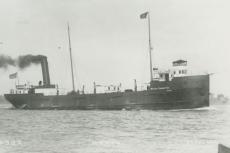As I stand on the upper deck of the Midnight Express, one of two dive boats operated by Olympus Dive Center, goose bumps cover my arms and a chill lies buried deep inside. Perhaps it is the weather or the dives awaiting me after the two hour cruise. More than likely it is both.
This brisk November morning, under skies laden with dark, cumulus clouds, the seas are rough and a most ominous stage is set. It will not be long before I explore an underwater tomb, a reminder of the wages of war, a remnant of the follies of man.
Contributed by
In search of answers to the mysterious sinking of U-352, the first German U-boat sunk in American waters in World War II that yielded prisoners of war and the subject of the upcoming dive, I ask George to share his considerable knowledge of the wreck and its history. So begins a pattern of asking questions and then furiously scribbling down George’s responses on a yellow tablet that is speckled with the dried droplets of ocean spray. As I listen, the story unfolds.
U-352
Commissioned by the German high command in October 1941, the U-352 and its crew were ordered to set sail for the North American Atlantic coast in the spring of 1942. Their mission was to disrupt allied shipping off North Carolina in an area infamously nicknamed Torpedo Alley by the U.S. Navy due to the numerous merchant ships that were preyed upon and sunk by U-boats.
The U-352’s relatively inexperienced crew of 46 men included three officers, the leader of which was Lieutenant Hellmut Rathke. Knowing the United States had failed to protect its waters, as evidenced by the hundreds of tankers and cargo ships that were successfully torpedoed along the east coast, Rathke was hungry for “easy” kills and the subsequent glory such victories would yield.
After only one week of playing cat and mouse with spotter planes and other American anti-submarine forces and failing to score his first prey, Rathke ordered his crew to perform a daylight attack on what he thought was a large merchant ship on 9 May 1942.
After maneuvering into position, a single torpedo was fired and thereafter a satisfying explosion was heard. Victory dances were short lived however, as predator become prey when Rathke found out the merchant ship was really the U.S. Coast Guard Cutter Icarus and the torpedo had apparently drilled the ocean bottom.
Reportedly, Rathke not only erred in improperly identifying his target, he was also confused on the U-352’s actual depth. In an attempt to hide from the Icarus and avoid potential disaster, Rathke grounded the submarine in the vicinity of the torpedo detonation.
Unfortunately for him and the rest of the U-352’s crew, the Icarus’ initial depth charges fell directly on top of the U-boat. What normally would have resulted in hours or even days of playing hide and seek with no guarantee of success, Icarus shot and scored triumph in minutes.
The U-352, with flooding in multiple compartments and having apparently lost both diesel and electric engines (though the officer in charge of the diesels was overheard stating that he could still get the engines to run), briefly surfaced, disgorged Rathke and 32 other frightened sailors, then sank to the bottom for good, entombing the remaining 13 crew members.
Sobering, puzzling thoughts arose during George’s account of the U-352’s fatal voyage. So many questions were left unanswered: Why was Rathke so confused about his depth? What led to the misidentification of the Icarus? What prompted him to break protocol by attacking during the day? How did the Icarus locate the U-352 on the first try? Why did Rathke not try to fight back with the deck guns when he surfaced?
What caused 13 crew members to go down with the ship? Why did U.S. intelligence officers allow three months to pass before interrogating the survivors? Why did I not know that U-boats were once so close to our shores that the crews could judge the distance to land at night by the intensity of the nearby lights (Thank God Hitler’s U-boats were not equipped with nuclear missiles!)?
Except for a brief examination by U.S. Navy divers in late 1942, the U-352 lay lost in time, 35 miles off the Morehead City coast and untouched by human hands for over 30 years.
While her whereabouts were unknown, the U-352 was definitely not forgotten. Claude Hull, often called the godfather of diving by many in the local community, spent countless hours researching and many years running grid patterns in hopes of finding the missing sub.
In a strange twist of fate, on the one day that Claude decided not to look for her, George, Rod Gross and Dale McCullough used his recommended coordinates and struck gold in April 1975. Now it is my turn to see what remains of U-352. ...
( ... )
Published in
- Log in to post comments

























































